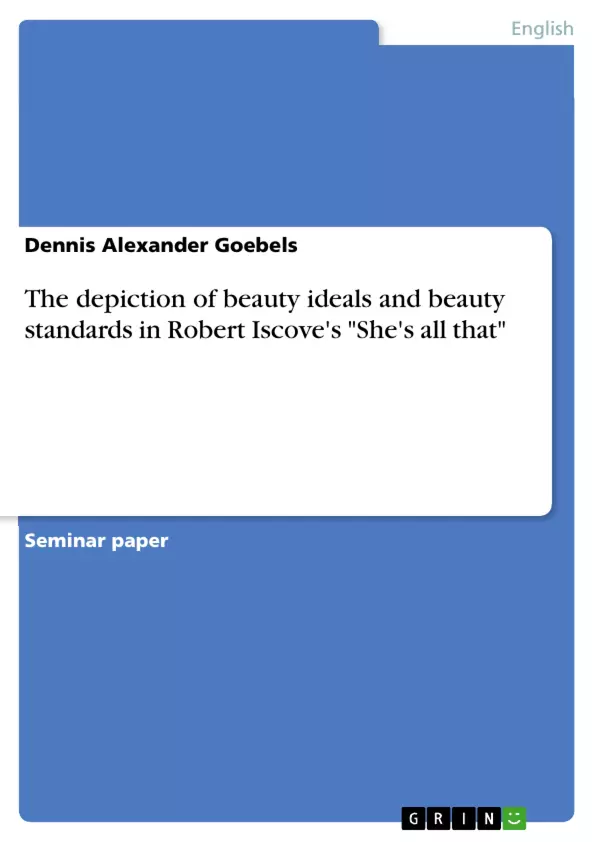In Robert Iscove’s "She’s all that" beauty ideals and beauty standards play a major role and the submission of Laney to these standards and ideals is the reason why Zack falls in love with her.
That is why I am going to argue that in Robert Iscove’s movie ideals of white, middle-class, male society are taken as a basis to prove that submission to these standards is the only way for women to be accepted by men.
Inhaltsverzeichnis (Table of Contents)
- Content of the movie
- Introduction
- The depiction of beauty ideals and beauty standards in She's all that
- Laney's original self
- Reactions to Laney's original self
- Female reactions
- Male reactions
- Laney's transformation
- Reactions to Laney's transformation
- Female reactions
- Male reactions
- Laney's reaction
- Conclusions
- Works Cited
Zielsetzung und Themenschwerpunkte (Objectives and Key Themes)
This paper analyzes the portrayal of beauty ideals and standards in Robert Iscove's film "She's All That." The objective is to demonstrate how the film uses the female protagonist's transformation to reinforce societal norms of beauty dictated by white, middle-class, male perspectives, ultimately suggesting that female acceptance hinges upon conforming to these standards.
- The impact of societal beauty standards on female self-perception.
- The role of male gaze and objectification in shaping female identity.
- The internalization of patriarchal norms by women.
- The contrast between inner beauty and outward appearance.
- The critique of superficiality and the pursuit of societal acceptance.
Zusammenfassung der Kapitel (Chapter Summaries)
Content of the movie: This section introduces the basic plot of "She's All That," focusing on the premise of a popular high school student, Zack, betting that he can transform an unpopular girl, Laney, into prom queen material. It highlights the initial contrast between Laney's artistic and socially conscious personality and her perceived unattractiveness, setting the stage for the film's exploration of beauty standards. The summary of the plot provides the foundation for understanding the subsequent analysis of beauty ideals within the film.
Introduction: The introduction clearly establishes the paper's central argument: that "She's All That" utilizes the transformation of Laney to exemplify how adhering to the beauty ideals of a dominant white, middle-class male society is presented as the only path to acceptance for women. This sets the framework for the subsequent analysis of the film's portrayal of beauty standards and their influence on female characters and their interactions.
The depiction of beauty ideals and beauty standards in She's all that: This chapter delves into a detailed analysis of Laney's character arc, starting with her "original self." The chapter contrasts Laney's inner beauty, revealed through her artistic pursuits and compassionate nature, with the superficial standards imposed upon her. It explores the reactions of both male and female characters to Laney before and after her physical transformation, examining how these reactions reflect and reinforce societal expectations.
She's All That: A Film Analysis - Frequently Asked Questions
What is the main focus of this academic paper?
This paper analyzes the portrayal of beauty ideals and standards in the movie "She's All That." It examines how the film uses the female protagonist's transformation to reinforce societal beauty norms, suggesting that female acceptance depends on conforming to these standards.
What are the key themes explored in the paper?
The paper explores several key themes, including the impact of societal beauty standards on female self-perception, the role of the male gaze and objectification in shaping female identity, the internalization of patriarchal norms by women, the contrast between inner and outer beauty, and a critique of superficiality and the pursuit of societal acceptance.
What is the structure of the paper?
The paper is structured with a table of contents, objectives and key themes, chapter summaries, and keywords. It begins with an introduction outlining the central argument and then moves into a detailed analysis of the film's depiction of beauty ideals and standards.
How does the paper analyze "She's All That"?
The analysis focuses on the character arc of Laney, the female protagonist. It compares her "original self" with her transformed self, examining how both male and female characters react to her before and after the transformation. The reactions are analyzed to reveal how they reflect and reinforce societal expectations of beauty.
What is the central argument of the paper concerning "She's All That"?
The central argument is that "She's All That" uses Laney's transformation to illustrate how conforming to the beauty ideals of a dominant, white, middle-class male society is presented as the only path to acceptance for women.
What aspects of Laney's character are analyzed?
The paper analyzes Laney's "original self," highlighting her artistic pursuits and compassionate nature, contrasting this with the superficial beauty standards imposed on her. It examines the reactions to both her original self and her transformed self, exploring how these reactions reinforce societal expectations.
What is covered in the "Content of the movie" section?
This section provides a summary of the plot of "She's All That," focusing on the premise of the bet and the initial contrast between Laney's personality and her perceived unattractiveness. This lays the groundwork for the analysis of beauty standards within the film.
What is included in the chapter summaries?
The chapter summaries provide concise overviews of each section of the paper, outlining the key points and arguments presented in the introduction, the analysis of beauty ideals in the film, and the conclusions drawn.
- Quote paper
- B.A. Dennis Alexander Goebels (Author), 2006, The depiction of beauty ideals and beauty standards in Robert Iscove's "She's all that", Munich, GRIN Verlag, https://www.grin.com/document/125011



